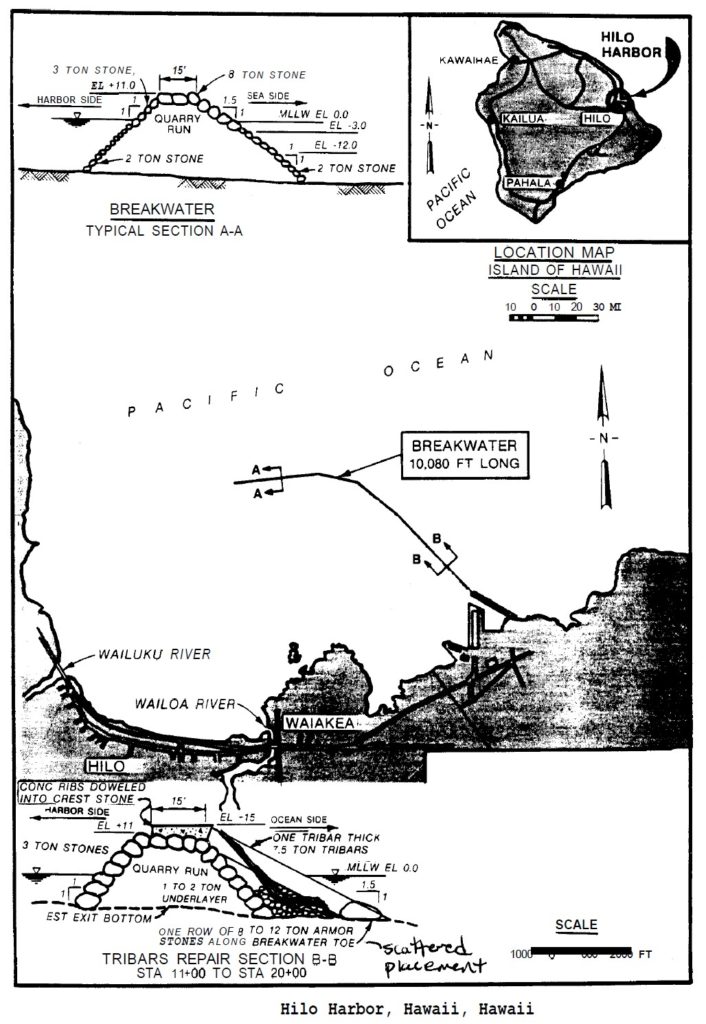Postal services in Hilo commenced in 1858. However, when the Hawaiian Islands became a territory of the US in 1900, officials determined that both postal and court facilities should be expanded to better serve the citizens. (GSA)
Likewise, a need was expressed in governmental correspondence for new federal and Territorial offices. Successive early Territorial governors agreed that a new federal office building should be constructed in Hilo. (NPS)
“A block was set aside in Hilo for public building purposes. Governor Frear recommended that it be cut in two, one half for federal purposes and the other half for territorial purposes.”
“Congress accented this proposal on condition that the government sell all the building then on the properties and devote the proceeds to building roads around and through the property as divided.” (Hawaiian Gazette, November 12, 1912)
New York architect Henry Whitfield designed the new building in 1915. Whitfield, who was Andrew Carnegie’s brother-in-law, had just completed the design for the Honolulu Carnegie Library. Whitfield designed the building in the Mediterranean Renaissance Revival style, which blends traditional classical architecture with features more suited to a tropical climate. (GSA)
“…the contract for the erection of the Hilo federal building had been let to the Campbell Construction Company of Salt Lake City at its bid of $185,522”. (Honolulu Star-Bulletin, April 10, 1914)
“Twenty-five per cent of the Hilo federal building is completed. One-fourth of the structure is finished; three-fourths more has to be done before the structure can be handed over to the eager public.”
“This good news will probably cause a stir or surprise in Honolulu, where they are still fighting and squabbling over the site for their federal building.”
“Hilo knew what she wanted some years ago and she has what she wants right now in the shape of a rapidly growing, federal building.” (Honolulu Star-Bulletin, November 8, 1917)
“’There have been delays, sure, but we fully expect to have the Hilo federal building finished and ready for a house warming by November 1,’ declared Mr Campbell, who represents the mainland contractors who secured the big job a couple of years ago.”
“’I would suggest Thanksgiving Day as the one to celebrate on, and I hope the contractor will have something to be thankful about when the job is pau that is the right word, isn’t it for all through.’”
“The federal building job has been delayed from time to time by the usual red tape and pass-it-along stunts of the Washington authorities. … The first Intention was to have a house warming about Christmas time, but there is now no need to wait until then.” (Honolulu Star-Bulletin, May 17, 1916)
The building was one of the first in Hawaiʻi constructed using reinforced concrete, a technology that was common on the mainland. Construction was completed and the building occupied in 1917.
It originally functioned as a courthouse, post office and custom house. Other tenants included the Immigration Bureau, Agricultural Extension Service, Weather Bureau and Internal Revenue Service. (GSA)
The original portion of the building was a rectangular structure with a portico on the main (south) side and a projecting wing on the north side.
The original portion has a full basement, a raised first floor two stories in height which contained the post office, a second floor one story in height which contained the court functions, and a fourth-story clerestory with windows above the original courtroom. (NPS)
By the 1930s, tenants required more space and two wings were added to the building between 1936 and 1938. Louis A Simon, supervising architect of the US Treasury, designed the wings in a style compatible with that of the original building.
The three stories of the additions correspond to the first, mezzanine and third floors of the original building. The result was a U-shaped building with a deep front courtyard overlooked by open verandas on three sides.
The clerestory, or band of windows, admits light into the interior of the third story; there are five skylights on the building, including one on the penthouse roof, that also serve to illuminate the interior.
It still houses federal agencies, although the main US Post Office was moved to a new building near the local airport in 1978, leaving a branch operation in its place. The Third Circuit Court vacated its courtroom and ancillary facilities on the third floor in 1979.
On Memorial Day in 1922, the American Legion planted 17 royal palms along Kekaulike Street to commemorate Hawaiian citizens who died in World War I. (GSA)











































